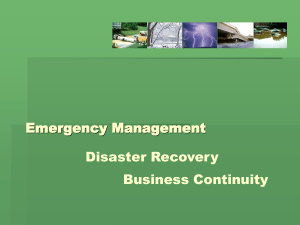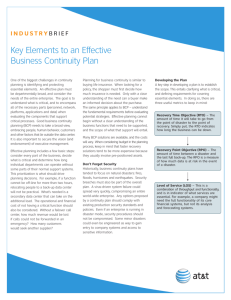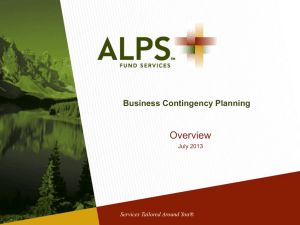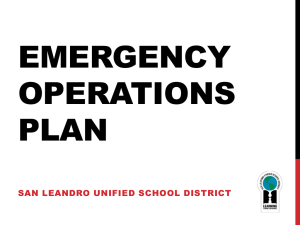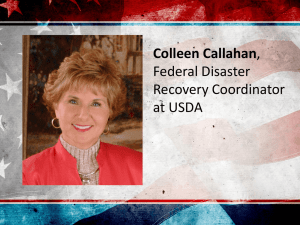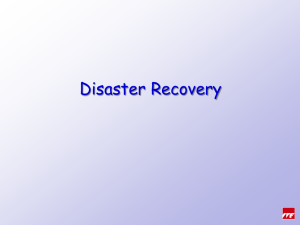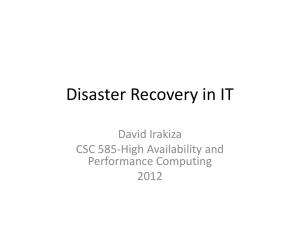Disaster Recovery Awareness PowerPoint
advertisement
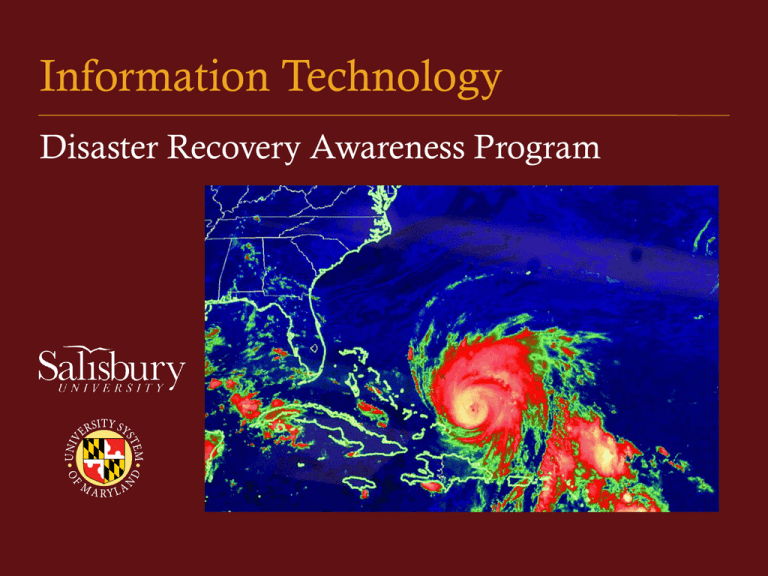
Information Technology Disaster Recovery Awareness Program Disaster Recovery Awareness What is Disaster Recovery? • From an IT perspective, any event that would affect the Fulton Hall Datacenter, but is not so severe as to shut the entire campus down permanently. • Some examples of this could be: Fire, Hurricane, Earthquake, and other natural or man-made disasters. • IT systems have become critical to the functioning of the University and as such it is essential that we create, test and maintain a plan to recover vital IT services to the campus. Disaster Recovery Awareness Disaster Recovery Terminology • RTO = Recovery Time Objective o The amount of time within which IT business processes must be restored after a disaster or disruption in service. o Our current RTO is to have most critical systems up within two weeks of a disaster. • RPO = Recovery Point Objective o The acceptable amount of data loss measured in time. o Our current RPO for most systems is one day. Email, Peoplesoft, and MyClasses have a one hour RPO. Disaster Recovery Awareness Business Continuity Plans • The recovery time objective (RTO) of the campus, in the event of a total data center total loss, is within two weeks. Although the data will be secure, the replacement equipment required to support the software will need to be purchased, installed and configured. From our experience gained in disaster recovery tests, we believe the first week will be required to install and configure equipment. Once the servers and drives are in place, data restoration can begin. While services are not in operation, campus business units will continue operation utilizing their departmentally developed business continuity plans. • How can your department continue functioning without IT services for up to two weeks? o o o o What business processes can be done manually? Does a paper method still exist for temporary use? What systems and services are necessary for your department to function? Documentation is vital, do any business processes only exist in someone’s head? Disaster Recovery Awareness Business Continuity Plans • These departmental Business Continuity Plans should be updated Annually. o With the rate of change in technology, it is helpful to review your BCP to make sure it is still current. o Staffing changes can also have a major impact on your BCP. • Some concrete examples of useful things to consider for your BCP: o In the event of a flood or hurricane, if we have advance notice, putting a trash bag over your computer & monitor and elevating the computer off of the floor on your way out can save valuable information. o Implementing a departmental policy to ensure files are stored on Network Drives and not personal computers. o It is helpful to periodically do a “Tabletop Exercise” where you step through your disaster recovery plan as a department and discuss “What if ?” scenarios. Disaster Recovery Awareness How We Protect Our Data • IT systems are backed up each night, critical databases are backed up every half-hour. • Backups are sent immediately as they are created to our remote site of Coppin University. • An additional backup copy is put onto tape once a month and stored in a vault off-campus. • Redundancy is built into as many systems as possible to prevent hardware failure and minor events from affecting business operations. • Certain equipment & tools to aid in recovery are placed in a secondary datacenter on-campus. Disaster Recovery Awareness Order of Recovery • Phase One: Communication – In order to enable the administration and public safety to post urgent communications intended for our students, employees, and outside public, we will restore the main campus website (www.salisbury.edu) first. – Once we have a web presence we will then restore the email system so that we can send updates to the campus. • Phase Two: Student and Financial Records – Any system such as Gullnet, that provides student or financial data is essential. – This will enable us to provide transcripts & student data for contact information as well as purchase replacement equipment and process payroll. • Phase Three: Instruction-Supporting Systems – MyClasses in order to provide web-enhanced instruction and distance learning. – Academic computing labs for instructor & student use. – Faculty instructional material stored on network drives ie O & P • Phase Four: Other Systems – All other applications and systems used by employees on campus not specifically addressed in the previous phases.
